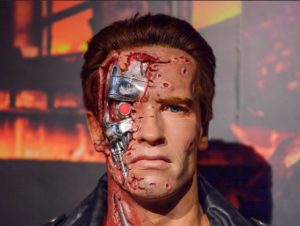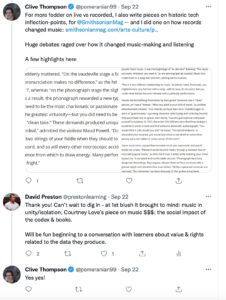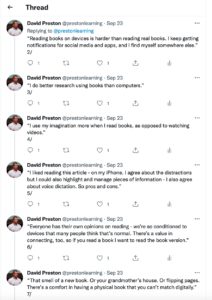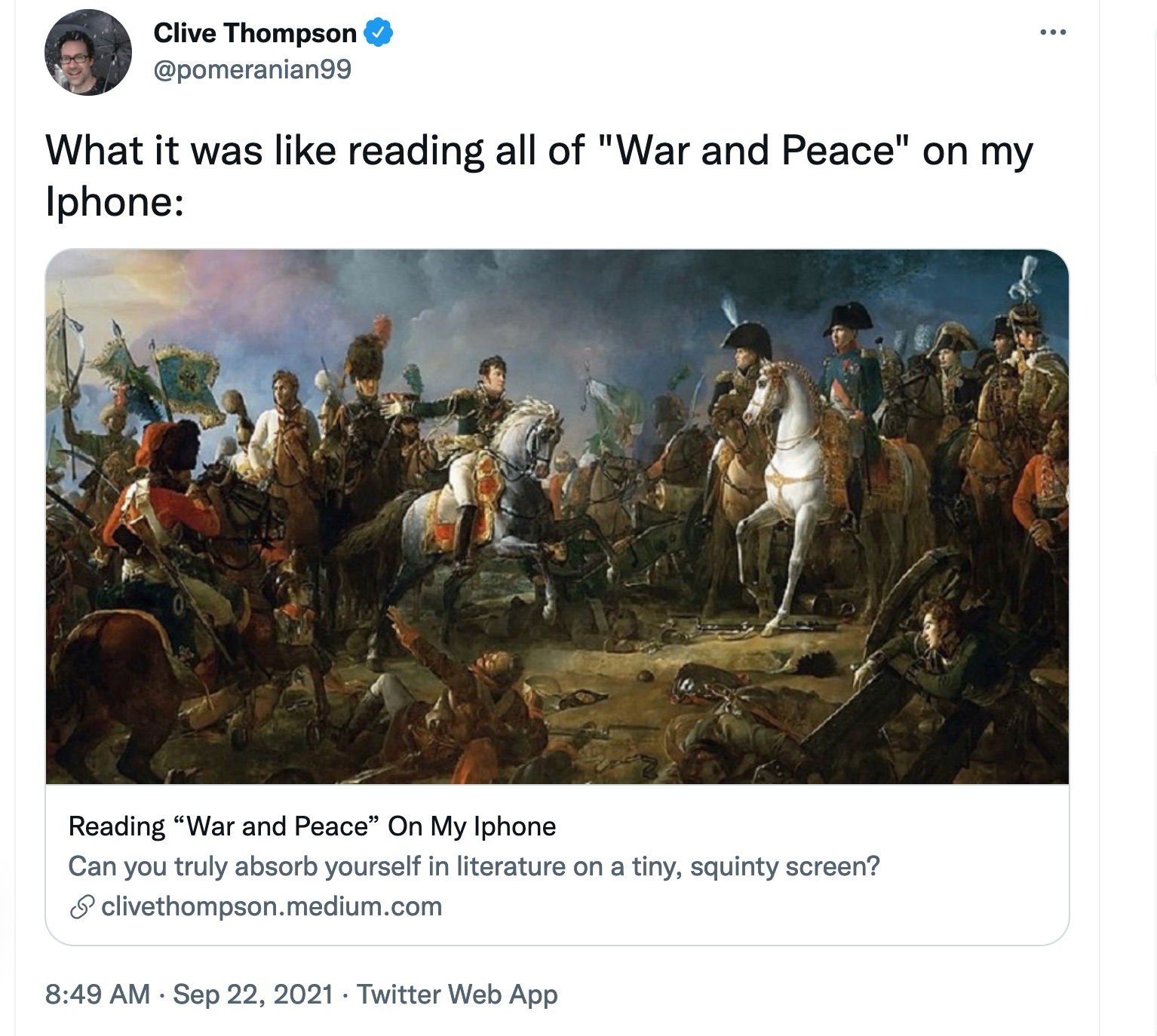Thinking about data
Last Wednesday I was preparing to meet with the Open-Source Learning Academy online. I wanted to get everyone thinking about data, and I had a question to start the conversation: Is a song the same song whether it’s performed live, played on vinyl (78, 45, 33 1/3), 8-track tape, cassette tape, CD, or streamed as an .mp3 or other digital format? Is it the same song when it’s played aloud in shared company, or experienced alone in a car, or a shower, or on headphones or earbuds?
In other words: Does the medium change the message? Is my idea the same when it occurs in my head as when I type it into a blog post, or on Word, or in Google Docs? Or does the way I communicate the idea change it – for me or anyone else?
Is your face the same on Zoom, or Meet, or in a picture frame, or inches from mine?
When we read a book, does the physical artifact change the way we experience the information in it? The feel of the cover, the smell of the pages, the knowledge that it’s ours and no one can sneak into our room and change it without us knowing or giving permission? Or is the text in a book the same by any other format – even more convenient, more portable, more immediate?
Spoiler: your phone is not a book. You may think that reading this sentence is the same as reading this sentence on a piece of paper. It’s not. This sentence looks like English, but it’s not – what you see is just a skin. Want proof? Copy and paste this paragraph into your favorite word processor or blogging platform and change the size, font, color, or language. These word-looking, human-friendly illusions are costumes for the underlying code, the ones and zeroes that form the backbone of programming languages and protocols that most of us don’t understand.

This post isn’t about some imaginary contest between phones and books. Phones and books are both wonderful, for very different reasons. Books are amazing in ways phones can’t touch. For their part, phones can do so much to connect and empower us, using books and many other resources. We need to learn how to use them both more effectively.
This post is about the information that makes both books and phones important and some ways we can share that information to create connection and value.
The Big Picture: Why we need to think about data
Before I get to the super cool story of how learners connected with an author online to engage with ideas and curate their thoughts, it’s worth asking why this all matters. I’ve been thinking about this with learners for a long time, and now it’s more important for everyone to understand than ever.
We are not operating in a vacuum. In our society and economy, we do specific things for specific reasons. The DNA of software is intention – computers do what we tell them to do.
Video conferencing and file-sharing applications can appear to function the same. However, if one version is built for exclusive, high-quality access, and another is built for privacy and sovereign identity, there will be some pretty significant differences under the hood.
Students’ data in a closed system managed by a private equity portfolio company is not the same as students’ data owned and shared by students in an open system.
Data creates value. Someone leverages that value. Cui bono?
We have been in the “Information Age” for decades and schools are still generally blowing it. Students and graduates become “Users” who blindly, routinely accept online terms of agreement against their best interests. Why? Because in school they were trained to point and click and follow orders, without learning about the nature of digital tools, online culture, or the economics of the internet. Without reading closely or thinking critically, or – heaven forbid – occasionally marshaling evidence and saying, “Are you kidding? No WAY!”
Schools require students to create content on platforms that companies design for profit. For example, students in my school district who are not enrolled in the Open-Source Learning Academy are required to use Canvas. Canvas is a branded product of a company called Instructure Holdings. According to Instructure’s website, “The Instructure Learning Platform makes edtech more personal and student success more equitable.”
A few months ago, Instructure held an IPO that valued the company at nearly $3 billion. The majority of Instructure’s board of directors are executives from Thoma Bravo, a private equity investment firm that took Instructure private just over a year earlier for about $2 billion. To my knowledge, not a single student or teacher who is required to use Canvas gets compensated in shares or cash payments for their contributions to the platform’s success. Students and teachers are not the beneficiaries of corporate or investor interests. According to the Thoma Bravo website: “Our mission is to deliver superior value to our investors and companies.”
Student success cannot be equitable when content creators are intellectual sharecroppers. Student success will be more equitable when students are empowered to choose the manner in which they create and share content. Selecting the right digital tools for the job requires us to understand the internet well enough to make decisions that help us own and manage our online identities and our data.
To help young people understand how to leverage digital information to their advantage, we have to empower them and do the work with them. We can’t afford to keep building private profit, calling it public good, raising intellectual veal, and then pretend to be surprised when people don’t research the issues before they decide whether to vote or get a vaccine.
Connecting over data
This brings us back to last Wednesday. Two minutes before I opened the Open-Source Learning Academy video conference to talk about what digital data is and how it can create value, I ran across this tweet from science and technology journalist Clive Thompson:

Perfect. War & Peace is a book that billions of people over the years have been taught to admire, even though most of them haven’t read it. Tolstoy’s classic is intimidating to adults and brutal to consider teaching in today’s high school.
To paraphrase Professor Faber from Fahrenheit 451, is it the book itself or what’s in the book that we admire? Would the history and the philosophical ideas in the book come through if it were presented in a different medium? Would the digital version be the same or different? I devoured Clive’s article and reflected on how his first-person account brought these issues to life.
At its best, Open-Source Learning connects people and ideas in ways that spark understanding and create value. When we reach out and invite others into the conversation, everything changes. Peers, experts, and people who care about us all influence the way we think and the things we think about. Plus, it’s cool to talk with the author of a text or the director of a movie. Experts are awesome. I’ve connected students with authors who are experts on everything from Shakespeare (check out author Fredrik DeBoer’s surprise appearance in the comments) to science fiction (with gratitude to Cory Doctorow).
In Clive’s tweet I saw an opportunity to share a resource from an informed, thoughtful expert. So I tweeted to Clive and we started a conversation:

Our exchange would have provided significant value even if it ended there. Students would learn from a near real-time artifact created by a leading thinker in the field, curated by a knowledgeable guide who would help them connect the dots between their phones, books, and one of the most revered pieces of literature ever written.
Creating opportunities through data
Clive and I also modeled the sort of civility and generosity that happens all the time on the internet and IRL, and gets exactly zero headlines. We live in a culture increasingly shaped by conflict, we need a TED talk to teach us the art of asking and letting people help, and most of us don’t learn anything about intellectual property in school.
Asking Clive’s permission to share his article created three important outcomes. First, I communicated that I saw value in his thinking worth sharing. Second, I acknowledged his ownership of his work. Third, by sharing an idea of my own, I invited him to reciprocate.
Clive replied by sharing another article he’d written for the Smithsonian magazine, that was exactly on point with the song-related idea I’d considered in the first place!
When the Open-Source Learning meeting began, students and I practiced mindfulness and wrote in our journals as usual. Then I hijacked my own agenda by introducing Clive’s article and asking if we could have a discussion about it. I showed everyone the exchange on Twitter and I asked if I could live-tweet our conversation. Students agreed, and you can see the thread here.


Now, instead of merely consuming War & Peace or Clive’s article, the students are contributing value of their own. First, in group feedback to Clive on his article, and then, under their own names on their own blogs, with their own ideas on the topic.
What you can do next
First, remember that a phone is not a book – AND YOU ARE MORE POWERFUL AND THOUGHTFUL THAN BOTH. Celebrate tools for what they are – ways of sharing ideas/ information/ data. Investigate all the communication tools you can find. Experiment with digital whiteboards, word clouds, images, animations, .gifs, videos, music, markdown language, and anything else you can think of – sharing what you find useful (and not) along the way is a valuable contribution.
If you are a learner, reach out to the people you respect and ask a question. Share an idea and ask for feedback. Offer something. Do this online and offline. The world will suddenly become more giving and generous.
If you are an employer or an educator, encourage the members of your network/s to connect and contribute. Be the person you know who is preparing yourself and others to thrive in virtual community. These practices are better than the new normal. They are the new awesome.
Curating personally meaningful learning will redefine how we live and work. I remember talking about this stuff with Doc Searls almost 20 years ago. Seems like a long time ago, but not really. Back then, Searls’ Cluetrain Manifesto – the book explaining how individuals sharing personally relevant ideas in their own authentic voices could somehow enrich social systems and markets – was considered a wild idea. Kind of like encouraging students to use the public internet.
Just in case you’re thinking, “Yeah, but still… young people need to sustain concentration and differentiate fact from fiction, so they should read books instead of the internet,” remember that previous social commentators – even authors themselves! – worried that reading novels would be just as bad for us.
Our world works better when people connect in systems and contribute value by sharing personally relevant ideas. Even when we disagree – especially when we disagree – communicating with each other forms bonds that lead to deeper understanding and more value. We are way beyond “keep your eyes on your own paper.” We face complicated problems that require collaboration and community to solve. Schools must adapt and prepare young people to thrive in an interdependent, interdisciplinary, interconnected world.
You can start right now. Please drop me a line on the Contact page to let me know what you think. Thanks for reading.
